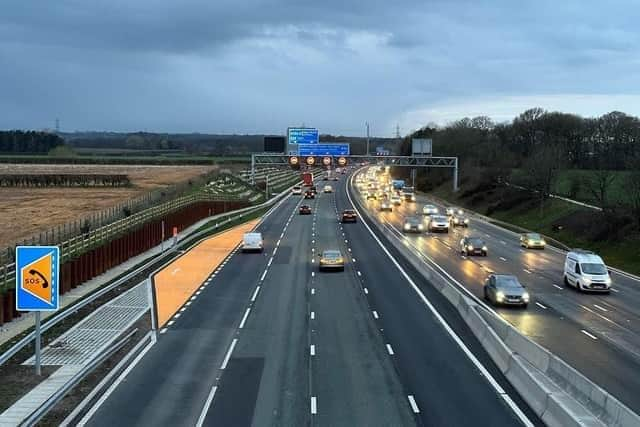AA calls progress on M6 upgrade ‘disappointing’ as update is given on extra safety features
and live on Freeview channel 276
Chief executive Nick Harris told MPs he is “confident” that the remaining ERAs will be in place as scheduled by the end of the year.
AA president Edmund King described the progress to date as “disappointing”.
Advertisement
Hide AdAdvertisement
Hide Ad

The project to retrofit smart motorways was announced on December 14 as part of a £900 million investment in safety improvements.
Mr Harris last week visited the site of the M6 upgrade – between junction 21a at Croft near Warrington and junction 26 at Orrell – which started in March 2021 and was due to be finished by last spring.
An extra lane is being added in each direction along ten miles of the M6, but work has been delayed by "a variety of factors" – including the installation of extra ERAs as a result of the government’s decision to cancel planned projects to build all-lane running (ALR) smart motorways, which do not have a hard shoulder.
The M6 motorway is now not expected to reopen fully until the spring of 2025.
Advertisement
Hide AdAdvertisement
Hide AdMr Harris told the Commons Transport Select Committee today (Wednesday): “Having done the visit, met the alliance of contractors working on the programme, I am confident that we will deliver the 150 (nationally) by the end of the road period.
“There’s a lot of planning required for a number of reasons.
“We want to make sure that they’re going into the most appropriate locations where they will add to safety.”
Roads minister Guy Opperman told the committee: “It is very important that we ensure that the delivery of all the extra safety measures … is delivered at pace and that we are ensuring the safety of these particular roads.”
Advertisement
Hide AdAdvertisement
Hide AdSpeaking after the hearing, Mr King said: “We have stated for more than a decade that these smart motorways should never have been developed or opened without full safety features in place to start with.
“There is a certain irony that £900 million is being spent to retrofit safety onto smart motorways.
“The additional 150 emergency areas, when constructed, should slightly improve the chances of being able to stop in a relative place of safety but reintroducing a hard shoulder together with emergency areas would be the safest move.
“It is disappointing that that just 13 of the forecast 150 emergency areas have been opened but at least National Highways said they were confident of completing them within the designated time scale.”
Advertisement
Hide AdAdvertisement
Hide AdA National Highways report published last month revealed that smart motorways without a hard shoulder are three times more dangerous to break down than those with an emergency lane.
The number of people killed or seriously injured after a stopped vehicle was hit by a moving vehicle was 0.21 per 100 million vehicle miles travelled on ALR smart motorways between 2017 and 2021.
That compares with rates of 0.07 on controlled smart motorways, which have variable speed limits but retain a hard shoulder, and 0.10 on conventional motorways.
National Highways said at the time that evidence shows all types of smart motorways are safer than conventional motorways in terms of deaths or serious injuries, and a series of safety improvements have been made since 2021.